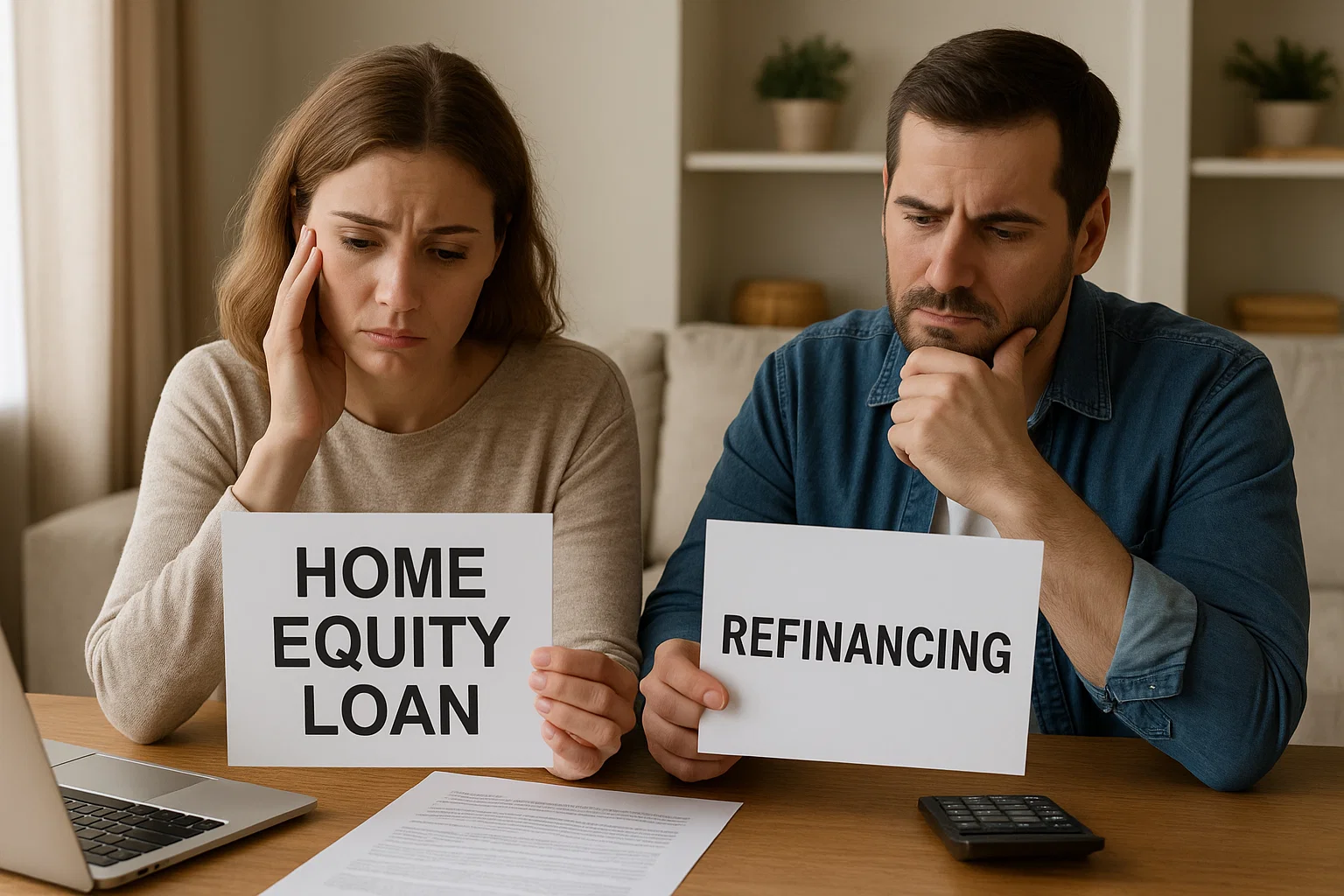.png)
Every homeowner eventually faces the question: should I refinance my mortgage? It's a decision that can feel overwhelming, especially when advertisements promise savings that seem too good to be true, friends share conflicting experiences, and financial advice varies depending on who you ask. The truth is that refinancing isn't universally beneficial—it's a highly personalized decision that depends on your unique financial situation, goals, timeline, and market conditions.
This guide provides a comprehensive framework for evaluating whether refinancing makes sense for you, helping you move beyond generic advice to make a confident, informed decision aligned with your specific circumstances.
Understanding Your Current Position
Before you can determine whether refinancing is right, you need a clear understanding of where you stand today. This baseline assessment forms the foundation for all subsequent analysis.
Your Current Mortgage Terms: Start by gathering your most recent mortgage statement and identifying key details: your current interest rate, remaining loan balance, monthly principal and interest payment, remaining loan term, and whether you're paying private mortgage insurance. These numbers provide the comparison benchmark for evaluating refinancing offers.
Your Home's Current Value: Property values fluctuate over time, and your home's current worth significantly influences refinancing options. If values have appreciated substantially since purchase, you've likely built equity that opens doors to better refinancing terms. Conversely, if values have stagnated or declined, refinancing options might be limited. Online valuation tools provide rough estimates, though lenders require professional appraisals for actual refinancing.
Your Financial Profile: Your credit score has likely changed since you originally financed—hopefully for the better through consistent payments and responsible credit management. Your income may have increased through career advancement or decreased due to life changes. Your debt levels might have shifted as you've paid off student loans, accumulated credit card balances, or taken on other obligations. Understanding your current credit score, income stability, and debt-to-income ratio reveals what refinancing options you realistically qualify for today.
Your Timeline: How long do you plan to remain in your home? This seemingly simple question often proves difficult to answer with certainty, yet it's crucial for refinancing decisions. Moving within two or three years typically doesn't provide sufficient time to recover closing costs through monthly savings. Conversely, planning to stay five, ten, or more years gives you ample time to benefit from improved terms.
The Core Refinancing Scenarios
Most homeowners considering refinancing fall into one of several common scenarios, each with different decision factors and optimal approaches:
Scenario 1: Interest Rate Opportunities

You purchased or last refinanced when rates were higher, and market rates have since declined by at least 0.5-1%. This scenario presents perhaps the clearest refinancing opportunity—capturing lower rates to reduce monthly payments and total interest paid over your loan's life.
The key question becomes whether monthly savings justify closing costs within your planned ownership timeline. If you'll save $200 monthly and closing costs total $8,000, you break even after 40 months—just over three years. Staying beyond this point means the remaining years deliver pure savings that compound into substantial long-term value.
Scenario 2: Credit Improvement
Your credit score has increased significantly since you originally financed—perhaps from 680 to 740+. Even if market rates haven't changed dramatically, your improved creditworthiness qualifies you for better rate tiers that weren't accessible before.
Calculate the rate difference between what you currently pay and what you qualify for today with your improved score. If the improvement is meaningful—say from 7.5% to 6.8%—refinancing captures this credit progress and converts years of responsible financial behavior into tangible monthly savings.
Scenario 3: Equity Building and PMI Elimination
You made a smaller down payment and have been paying private mortgage insurance monthly. Through principal payments and property appreciation, you've now crossed the 20% equity threshold where PMI becomes unnecessary.
Refinancing to eliminate PMI can save $100-300 monthly depending on your loan amount—substantial savings that don't require rate improvements to justify refinancing. Calculate whether PMI elimination alone recovers closing costs within a reasonable timeframe, even if your new interest rate matches or slightly exceeds your current one.
Scenario 4: Life Stage Transitions

Your financial circumstances have changed substantially since purchasing. Perhaps your income has increased significantly, allowing you to comfortably afford higher monthly payments in exchange for a shorter loan term. Or maybe you're approaching retirement and want to eliminate mortgage debt before income decreases. Life transitions create refinancing motivations beyond simple rate improvements.
Consider how refinancing helps you adapt your mortgage to your current life stage and priorities rather than maintaining terms established during different circumstances years ago.
Scenario 5: ARM Adjustment Concerns
You have an adjustable-rate mortgage approaching its adjustment period, and you're concerned about potential payment increases if rates rise. Converting to a fixed-rate mortgage provides payment certainty and protection against future rate volatility.
Calculate the cost of switching to fixed rates versus the risk of ARM adjustments. If you're within a year or two of your adjustment period and fixed rates remain attractive, refinancing now locks in stability before uncertainty arrives.
Scenario 6: Debt Consolidation Needs
You're carrying substantial high-interest debt—credit cards at 18-25%, personal loans at 12-15%—that strains your monthly budget. A cash-out refinance allows consolidating this expensive debt into your mortgage at 6-7% rates, potentially saving hundreds monthly while simplifying finances.
However, this scenario requires honest self-assessment. If overspending created the debt, refinancing without addressing underlying behavioral issues simply converts unsecured debt into secured mortgage debt while freeing credit limits to accumulate new balances—a potentially catastrophic pattern.
The Decision-Making Framework
Once you've identified your scenario and circumstances, work through this systematic evaluation framework:
Step 1: Calculate Your Break-Even Point
Divide total closing costs by your expected monthly savings to determine how many months of payments are needed to recover upfront expenses. If the result is 24-36 months and you're confident about remaining in your home for 5+ years, refinancing likely makes sense. If break-even extends beyond 48 months or approaches your planned ownership duration, refinancing becomes questionable.
Step 2: Model Complete Financial Scenarios
Don't stop at monthly payment comparisons. Calculate total interest paid over your current mortgage's remaining life versus total interest under proposed refinancing over the new loan's complete term. Sometimes lower monthly payments mask higher lifetime costs due to extended loan terms.
Create spreadsheets or use online calculators to model both scenarios completely, including the impact of closing costs added to your loan balance if you choose that option. Understanding total long-term costs reveals whether apparent savings are genuine or illusory.
Step 3: Assess Opportunity Costs
Money spent on closing costs—whether paid upfront or rolled into your loan—isn't available for other purposes. Could those funds deliver better returns if invested elsewhere? Could they eliminate high-interest debt more cost-effectively than refinancing? Consider whether refinancing represents your optimal use of available capital or if alternative strategies might serve you better.
Step 4: Evaluate Stability and Risk Factors
How stable is your employment and income? Are you approaching major life changes like retirement, career transitions, or family expansions? Refinancing commitments extend 15-30 years into the future—ensure your circumstances support maintaining this obligation throughout that duration rather than creating commitments you might struggle to honor if situations change.
Step 5: Compare Multiple Refinancing Options
Don't evaluate refinancing as a binary yes-no decision. Compare multiple structures: 30-year versus 15-year terms, rate-and-term versus cash-out options, traditional refinancing versus no-closing-cost alternatives. Each offers different trade-offs between monthly costs, total interest, loan duration, and upfront expenses. Understanding the full spectrum of options reveals which structure best aligns with your priorities.
When Refinancing Doesn't Make Sense
Sometimes the smartest decision involves keeping your current mortgage despite refinancing opportunities that appear attractive on the surface:
Short Remaining Timeline: If you plan to sell or move within 2-3 years, refinancing rarely provides sufficient time to recover closing costs through monthly savings.
Limited Rate Improvement: Rate reductions below 0.5% typically don't generate enough savings to justify refinancing costs and effort unless you have an exceptionally large loan balance.
Recent Refinancing: If you refinanced within the past 12-24 months, refinancing again means paying closing costs twice in a short period—expensive churning that rarely delivers net benefits.
Unstable Financial Situation: During job transitions, income uncertainty, or financial instability, committing to new mortgage terms introduces risk precisely when flexibility matters most.
Late-Stage Mortgages: Homeowners with only 5-7 years remaining on their mortgages have crossed the amortization inflection point where payments now substantially reduce principal rather than paying interest. Refinancing resets this progress and may cost more despite lower rates.
Making Your Final Decision
Armed with complete analysis, make your decision based on concrete numbers rather than emotions, marketing messages, or fear of missing out. If refinancing delivers clear financial benefits—meaningful monthly savings, substantial lifetime interest reduction, strategic access to equity, or important payment stability—that justify closing costs within your realistic timeline, proceed with confidence.
If analysis reveals marginal benefits, extended break-even periods, or uncertain circumstances that complicate long-term commitments, maintaining your current mortgage often proves wiser than pursuing refinancing that might not deliver promised value.
Remember that refinancing is always optional. Unlike mortgage payments that arrive monthly whether you're ready or not, refinancing happens only when you initiate it. This gives you control over timing and terms, allowing you to wait for truly compelling opportunities rather than accepting mediocre improvements simply because they're available.
Conclusion
Determining whether refinancing is right for you requires moving beyond simplistic rules of thumb toward comprehensive analysis of your unique situation. By understanding your current position, identifying which scenario describes your circumstances, calculating complete costs and benefits, and honestly assessing your timeline and stability, you create the foundation for confident decision-making that serves your long-term financial interests.
Refinancing represents a powerful tool for optimizing your largest monthly expense and aligning your mortgage with current financial realities. But like any tool, its value depends entirely on using it appropriately for situations where it genuinely helps rather than applying it universally regardless of fit. Take the time to work through this framework thoroughly, consult with trusted advisors who understand your complete financial picture, and make your decision based on analysis rather than assumption. When circumstances truly align favorably, refinancing delivers substantial value that compounds into significant financial advantages supporting the secure, prosperous future you're building.

Alex Chen

Alex Chen













Get in touch with a loan officer
Our dedicated loan officers are here to guide you through every step of the home buying process, ensuring you find the perfect mortgage solution tailored to your needs.
Options
Exercising Options
Selling
Quarterly estimates
Loans
New home

Stay always updated on insightful articles and guides.
Every Monday, you'll get an article or a guide that will help you be more present, focused and productive in your work and personal life.









.png)
.png)
.png)
.png)
.png)
.png)
.png)
.png)
.png)
.png)
.png)
.png)
.png)
.png)
.png)
.png)
.png)